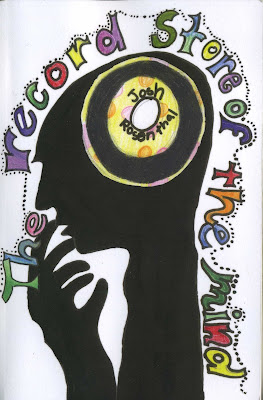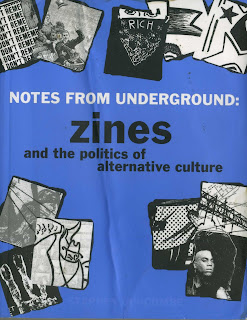
These three titles seem to fit together well, being as they each explore US subcultural activity and are published outside the mainstream by informed enthusiasts.
The most recently published (2015) is 'The Record Store of the Mind' by Josh Rosenthal who established and runs the very excellent Tompkins Square indie record label based in San Fran following a gold-plated career at Columbia Records.
THE GENERALIST was first contacted by Josh after he'd read my review of a great musical night in Brighton featuring the legendary Michael Chapman and the younger guitar wunderkind William Tyler back in April 2011. I followed this up with a post on the TS label itself and reviewed four albums. His label specialises in what Greil Marcus calls "old weird American music" and new cult Americana and folk artists.
He's got great style and taste which have already earned him seven Grammy nominations to date. T. Bone Burnett rightly points out that Josh runs in a lineage that includes the musicologist, record producer and pioneer writer on the blues Samuel Charters (2015 obit here) and Harry Smith, a star-crossed genius generalist perhaps best known for his influential 'Anthology of American Folk Music', This extraordinary six-album set, released in 1952 on Folkways Records, comprises 84 American folk, blues and country music recordings on 78s issued between 1927 to 1932. It blew Bob Dylan's mind and every other folk, blues and country musician who heard it. It blew my mind too and remains the most expensive record purchase I've ever made but worth it ten times over. I digress.
Josh's first book on the TS label gives you a great flavour of the man himself and is packed with his arcane knowledge and savvy. His constant enthusiasm for searching our rare, cult and forgotten music is exemplary and in several chapters we follows his life journey that led him found his label, There's some great lists of mouth-watering records, a chapter on the stand-out gigs he's seen which is damn impressive and, the bulk of the book - profiles of unsung artists who deserve wider recognition, such as Ron Davies, who wrote songs with Gram Parsons, and 'penned It Ain't Easy' which Bowie recorded on 'Hunky Dory in 1971. My favourite chapters were an appreciation of Harvey Mandel and 'Obscure Giants of Acoustic Guitar.' Favourites for entirely selfish reasons.
Harvey Mandel has always been important because of his instrumental album 'Christo Redentor' featuring a stellar group of session musicians and released in the UK in the spring/summer of 1969. 'Wade in The Water' was the song of those halcyon days. Also lucky enough to see him play with Canned Heat at the Dome in Brighton. Josh's essay has encouraged me to track down other Mandel albums as yet unheard.
The Obscure Giants leads off with the great Jon Fahey, a seminal figure whose 'Blind Joe Death' record is a must. Fahey had an encyclopaedic knowledge of early American music and his own stuff haunts me still. Met him in Brighton when he was supporting 'Pentangle'. He was slightly the worse for wear that night and it led me to conducting one of my strangest interviews when he insisted I keep asking him questions while he was having a dump in the artist's backstage toilets.
 This small chunky rather creased second-hand copy is the 2008 sccond edition of Stephen Duncombe's 'Notes from Underground: Zines and the Politics of Alternative Culture' published by Microcosm Publishing in Portland, Oregon. Duncombe has quite a rap sheet.. A life-long political activist, he co-founded a community based advocacy group in the Lower East Side of Manhattan and working as an organizer for the NYC chapter of the international direct action group, Reclaim the Streets. He is currently co-founder and co-director of the Center for Artistic Activism, a research and training institute that helps activists to think more like artists and artists to think more like activists. He is also Professor of Media and Culture at the Gallatin School of Individualized Study and the Department of Media, Culture and Communications at the Steinhardt School of New York University. Amongst his other books are the 'Cultural Resistance Reader; White Riot: Punk Rock and the Politics of Race'.
This small chunky rather creased second-hand copy is the 2008 sccond edition of Stephen Duncombe's 'Notes from Underground: Zines and the Politics of Alternative Culture' published by Microcosm Publishing in Portland, Oregon. Duncombe has quite a rap sheet.. A life-long political activist, he co-founded a community based advocacy group in the Lower East Side of Manhattan and working as an organizer for the NYC chapter of the international direct action group, Reclaim the Streets. He is currently co-founder and co-director of the Center for Artistic Activism, a research and training institute that helps activists to think more like artists and artists to think more like activists. He is also Professor of Media and Culture at the Gallatin School of Individualized Study and the Department of Media, Culture and Communications at the Steinhardt School of New York University. Amongst his other books are the 'Cultural Resistance Reader; White Riot: Punk Rock and the Politics of Race'.
Its a wonderful and absorbing and detailed study of largely American fanzines. It began when Stehen stayed at a friend's apartment in Boston and came across a scattered collection of zines. He writes:
'I was awestruck. Somehow these little smudged pamphlets carried within them the honesty, kindness, anger, the beautiful inarticulate articulateness, the uncompromising life that I had discovered (and lost) in music, then later radical politics, years ago. Against the studied hipness of music and style magazines, the pabulum of mass newsweeklies, and the posturing of academic journals, here was something completely different.
'In zines, everyday oddballs were speaking plainly about themselves and our society with an honest sincerity, a revealing intimacy, and a healthy "fuck you" to sanctioned authority — for no money and no recognition, writing for an audience of like-minded misfits. Later I picked up a thick journal crammed with zine reviews called 'Factsheet Five', leafed through their listings, and sent off for hundreds of zines. I discovered tens of thousands more at the zine archive housed in the New York State Library. I even began to publish my own zine and traded mine for others. As I dug through mountains of these piquant publications, a whole world that I had known nothing about opened up to me. It was incredibly varied: zines came in more shapes, styles, subjects, and qualities than one would imagine. But there was something remarkable that bound together this new world I had stumbled upon: a radically democratic and participatory ideal of what culture and society might be... ought to be.'
 Duncombe argues that 'zines and underground culture offer up an alternative, a way of understanding and acting in the world that operates with different rules and upon different values than those of consumer capitalism. It is an alternative fraught with contradictions and limitations...but also possibilities.
Duncombe argues that 'zines and underground culture offer up an alternative, a way of understanding and acting in the world that operates with different rules and upon different values than those of consumer capitalism. It is an alternative fraught with contradictions and limitations...but also possibilities. The book concludes that zines still matter in the digital age. 'Self-publishing may have been democratized with the rise of the internet, but within the zine scene Do-It-Yourself is more than just a publishing practice. It is an entire way of thinking, being and creating; a shared ideal of what culture, community, and creativity could be. It is this subterranean vision that needs to be nurtured...and shared. Zines do this, and that's why they matter. They are, still, notes from the underground.'

Finally we come to 'What Was The Hipster: A Sociological Investigation', published in 2010 by the n+1 Foundation, New York. The teaser on the back reads, in part.
'Who was the turn-of-the-century hipster? Who is free enough of the hipster taint to write the history without contempt or nostalgia....A panel of writers invited the public to join an investigation into the rise and fall of the contemporary hipster. Their debate took place at the New School University in New York City and was followed by articles, responses and essays, all printed here for the first time.'The book works almost like a parody of an academic conference on one aspect of street culture, with a range of cultural views on who, what, when and why hipster is. You''ll find it amusing and infuriating but there's humour there and references back to the hipster movement of the '50s, as captured in Norman Mailer's classic essay 'The White Negro.,'
This extract is from a position paper entitled 'Positions' by Mark Grief. It includes three efforts to define WHAT WAS THE HIPSTER?
'Definition 3, and the one with which I think I might get the most traction. The "hipster" is the name for what we might call the "hip consumer" or what Tom Frank used to call the "rebel consumer."
The hipster is by definition the person who does not create real art. If he or she produced real art, he could no longer be a hipster. It has long been noticed that the majority of people who frequent bohemia are what are sometimes called hangers-on or poseurs, art aficionados rather than art producers.
The hipster is the cultural figure of the person, very possibly, who now understands consumer purchases within the familiar categories of mass consumption (but still restricted from others) — like the right vintage T-shirt, the right jeans, the right foods for that matter — to be a form of art.
What else might mark such a person off from the old and immemorial line of snobs and slummers is the puzzling part.
I take it that "hipster" as a name points to the fact that something has become even more drastic, or set apart, again, about these people's status as possessors of knowledge; and that, if we believe there is something essential about 1999 that lasts to the present, it is that the acquisition and display of taste before anyone else has also been radicalized, by the new forms of online capitalism; so that it is increasingly hard to possess, for example, popular music that everyone else can't also immediately possess after widespread internet use.
The 2009 hipster becomes the name for that person who is a savant at picking up the tiny changes of consumer distinction and who can afford to live in the remaining enclaves where such styles are picked up on the street rather than, or as well as, online. I suspect those definitions are wrong, but I offer them for what they're worth. I hope they will form a basis for conversation.'
DIG IT !


No comments:
Post a Comment